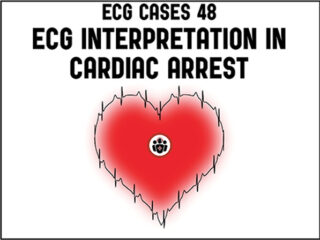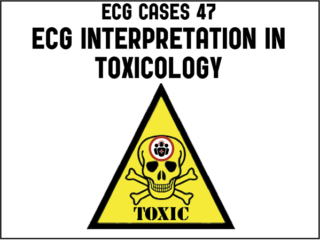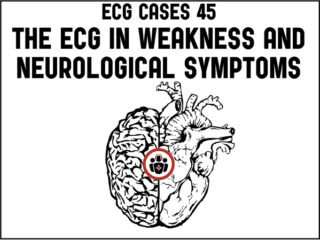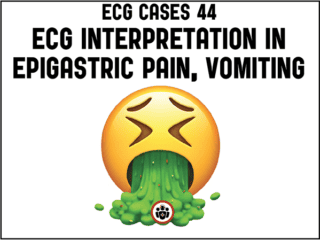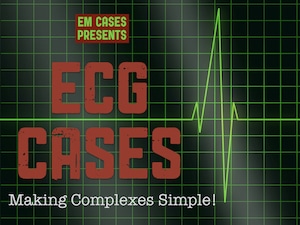
ECG Cases – Making complexes simple is a monthly blog by Jesse McLaren (@ECGcases), a Toronto emergency physician with an interest in emergency cardiology quality improvement and education. Each post features a number of ECGs related to a particular theme or diagnosis (with a focus on acute coronary occlusion), so you can test your interpretation skills. We challenge you with missed or delayed diagnosis, those with false positive diagnosis, and those that had a rapid and correct diagnosis. Cases are followed by a quick summary of the literature that relates to the cases, and we bring it home with practice changing pearls that you can use on your next shift.
Share your interesting ECGs with us!
ECG Cases 49 – ECG and POCUS for Dyspnea and Chest Pain
In this ECG Cases blog, Jesse McLaren and Rajiv Thavanathan explore how ECG and POCUS complement each other for patients presenting to the emergency department with shortness of breath or chest pain. They explain complementary diagnostic insights into pericardial effusion and cardiac tamponade, occlusion MI and RV strain...
ECG Cases 48 – ECG Interpretation in Cardiac Arrest
In this month's ECG Cases blog Dr. Jesse McLaren reviews interpretation of the pre-arrest ECG: identifying high risk ECGs requiring empiric treatment like calcium for hyperkalemia, magnesium for long QT, or reperfusion for Occlusion MI; the intra-arrest ECG: identifying pseudo-PEA; and post-arrest ECG: the importance of serial ECGs to reduce false positive STEMI, role of POCUS to help with the differential of diffuse ST depression with reciprocal ST elevation in aVR, and identifying signs of Occlusion MI/ false negative STEMI...
ECG Cases 47 – ECG Interpretation in Toxicology
In this ECG Cases Dr. Jesse McLaren delves into ECG interpretation in toxicology and the poisoned patient using his HEARTS approach in 7 case examples. Heart rate/rhythm: consider antidotes for brady/tachy-arrhythmias, and for sinus tachycardia consider fluids for vasodilation and benzodiazepines for agitation. Electrical conduction and axis: consider sodium bicarb for QRS > 100 especially if RBBB or terminal rightward shift, and magnesium for QTc> 500. ST/T changes: consider the differential including demand ischemia, associated electrolyte abnormalities, Brugada pattern from sodium channel blockade, and acute coronary occlusion vs vasospasm from cocaine...
ECG Cases 46 ECG in Fever and Infectious Disease
In this ECG Cases blog Dr. Jesse McLaren guides us through 10 cases, driving home the points that sepsis is a common cause of rapid Afib and diffuse ST depression with reciprocal ST elevation in aVR, myo/pericarditis is a diagnosis of exclusion, endocarditis or lyme carditis can cause AV block, PE can cause low grade fever and ECG signs of acute RV strain and that fever can unmask Brugada syndrome...
ECG Cases 45 ECG in Weakness and Neurological Symptoms
In this ECG Cases blog Dr. Jesse MacLaren guides us through 10 cases of patients who present with generalized weakness or acute neurologic symptoms and discusses how to look for ECG signs of dysrhythmias, electrolyte emergencies, acute coronary occlusion, and demand ischemia in patients with generalized weakness and in patients with neurologic symptoms, to consider predisposing factors like LVH; seizure-like activity from cardiac syncope; TIA/CVA embolic sources like atrial fibrillation or LV thrombus; or cardiac complications like stress-induced cardiomyopathy...
ECG Cases 44 ECG Interpretation in Epigastric pain, Vomiting
In this ECG Cases blog with Dr. Jesse McLaren we interpret 10 ECG cases and explore cardiac, metabolic and GI causes: We consider anginal equivalents, and look for ECG signs of Occlusion MI, including subacute occlusion from delayed presentations. We consider electrolyte disturbances and look for ECG signs of hyperkalemia or hypokalemia/hypomagnesemia, and we consider the differential of diffuse ST depression with reciprocal ST elevation in aVR, and false positive STEMI...


